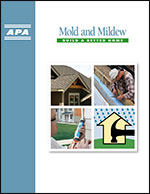BUILD A BETTER HOME: CONTROLLING MOLD AND MILDEW
Build a Better Home: Controlling Mold and Mildew
Note to Homeowners: It's the Water, Not the Wood.
Excessive or chronic moisture in your house can compromise its value. It's critical to be on the lookout for signs of moisture, and to take action to correct the cause of the problem.
Understanding Mold and Mildew
 Build a Better Home: Controlling Mold and Mildew
Build a Better Home: Controlling Mold and Mildew
Because mold and mildew can be symptoms of poor building envelope performance, it's important to understand how and why it occurs. Controlling Mold and Mildew outlines the following:
- ‣ What are mold and mildew?
- ‣ Environments in which mold and mildew grow
- ‣ Cleaning mold and mildew
- ‣ Control of mold and mildew in wood structures
Why Moisture Problems Are On The Rise
Homes are built to control moisture through design features like overhangs, gutters and flashing. However, some modern homes, for a variety of reasons, have encountered moisture-related performance problems. One of the causes, undoubtedly, is that houses today are designed and built with more corners, angles, hips, slopes, nooks, crannies, and other design features that place greater demands on proper detailing and workmanship to keep the weather and water out. Those demands are not always met. Compounding the problem is the growing shortage of skilled construction workers. Modern energy codes may also be a contributing factor. By encouraging houses to be sealed tightly, these codes, experts point out, can exacerbate interior condensation problems, as well as indoor air quality concerns.